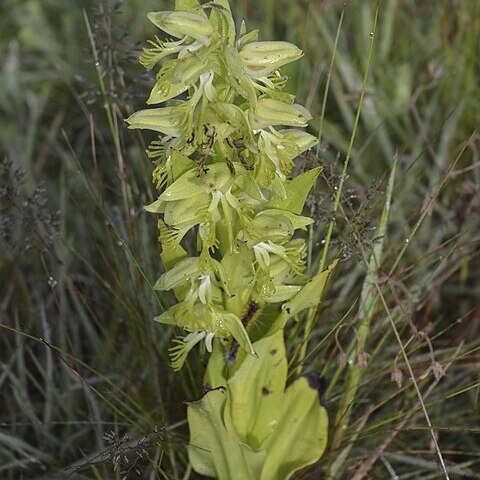Lip 30–40 mm long, 3-lobed with a basal claw 4–10 mm long; claw and basal part of lobes densely pubescent; mid-lobe 13.5–22 × 1 mm, linear; side lobes diverging, 16–23 mm long, much divided into comb-like segments on the outer margins; spur 12–22 mm long, straight or sigmoid, swollen to c. 2 mm wide at the tip.
An orchid. It grows 30-100 cm tall. There are 6-12 leaves and the lowest 2 sheath the stem. The flowering shoot is 13-25 cm long by 4-8 cm wide. There are many flowers in a dense group. The flowers are green with a white centre. The tubers are 3.5 cm long.
Leaves 6–12, the lower 2–3 sheath-like, the rest spreading, decreasing in size towards the stem apex, the largest 10–25 × 3–6 cm, lanceolate, acute, light green with 3 or 5 prominent longitudinal veins.
Dorsal sepal 13–22 × 7–10 mm, ovate, erect, convex; lateral sepal 15–22 × 6–11 mm, obliquely lanceolate, acuminate, spreading.
Petals 15–21 × 3.5–6 mm, curved-lanceolate, acute or obtuse, adnate to dorsal sepal, entire, erect, glabrous.
Robust terrestrial herb 30–100 cm high; tubers up to 3.5 cm long, ovoid or ellipsoid, woolly.
Inflorescence 13–25 × 4–8 cm, densely many-flowered; bracts leafy, 28–50 mm long.
Stigmatic arms 8–12.5 mm long, the receptive surface swollen, c. 4.5 mm long.
Anther c. 3 mm tall, connective 11–16 mm wide; canals 3.5–4 mm long.
Staminodes globose on slender stalks.
Ovary and pedicel 15–25 mm long.
Flowers green, white in centre.

